Using Recycled Material from the Paper Industry as a Backfill Material for Retaining Walls near Railway Lines
Abstract
1. Introduction
2. Materials and Methods
2.1. Material Used
2.2. Methods
2.2.1. Testing of Raw Materials
2.2.2. Preliminary Laboratory Tests of Composite
- -
- The material was moistened to the maximum water content (wmax) and cured in the open air,
- -
- The material was moistened to the optimal water content (wopt) and cured in closed boxes.
2.2.3. Test of Pilot Structure
2.2.4. Long-Term Monitoring
3. Results and Discussion
3.1. Raw Material
3.2. Results of Preliminary Laboratory Tests
3.2.1. Unconfined Compressive Strength—qu
3.2.2. Time Effect
3.2.3. Standard Proctor Tests (SPP)
3.2.4. Frost Resistance
3.2.5. Shear Properties
3.2.6. Composite Used for Backfill Material
3.3. Results from the Pilot Structure
3.3.1. Field Tests
3.3.2. Laboratory Tests of Samples from the Pilot Retaining Wall
3.4. Results of the Long-Term Monitoring
3.4.1. Stability of the Landslide
3.4.2. Environmental Monitoring
4. Conclusions
5. Patents
Author Contributions
Funding
Institutional Review Board Statement
Informed Consent Statement
Data Availability Statement
Conflicts of Interest
References
- UEPG. Annual Review 2017–2018; UEPG: Brussels, Belgium, 2018. [Google Scholar]
- Oyedele, L.O.; Ajayi, S.O.; Kadiri, K.O. Use of recycled products in UK construction industry: An empirical investigation into critical imepiments and strategies for improvement. Resour. Conserv. Recycl. 2014, 93, 23–31. [Google Scholar] [CrossRef]
- Poulikakos, L.D.; Papadaskalopoulou, C.; Hofko, B.; Gschosser, F.; Falchetto, A.C.; Bueno, M.; Arraigada, M.; Sousa, J.; Ruiz, R.; Petit, C.; et al. harvesting the unexplred potential of European waste material for road construction. Resour. Conserv. Recycl. 2017, 116, 32–44. [Google Scholar] [CrossRef]
- Garside, M. Paper Industry—Statistics & Facts. Statista. 2019. Available online: https://www.statista.com/topics/1701/paper-industry/Published (accessed on 4 January 2021).
- Zhang, C.; Jiang, G.; Liu, X.; Wang, Z. Lateral displacement of silty clay under cement−fly ash−gravel pile−supported embankments: Analytical consideration and field evidence. J. Cent. South Univ. 2015, 22, 1477–1489. [Google Scholar] [CrossRef]
- Monte, M.C.; Fuente, E.; Blanco, A.; Negro, C. Waste management from pulp and paper production in the European Union. Waste Manag. 2009, 29, 293–308. [Google Scholar] [CrossRef]
- IPPC. Council Directive 96/61/EC of 24 September 1996 concerning Integrated Pollution Prevention and Control (IPPC). Off. J. 1996, 257, 10. [Google Scholar]
- EAA. The Roadmap to a Resource Efficient Europe (EU COM 2011/571); European Commission: Brussels, Belgium, 2011. [Google Scholar]
- Fischer, C.; Lehner, M.; McKinnon, D.L. Overview of the Use of Landfill Taxes in Europe. 2012. Available online: https://ec.europa.eu/environment/waste/pdf/strategy/3.%20%20Christian%20Fischer%20EEA%20Landfill%20taxes.pdf (accessed on 4 January 2021).
- Watkins, E.; Hogg, D.; Mitsios, A.; Mudgal, S.; Neubauer, A.; Reisinger, H.; Troeltzsch, J.; Van Acoleyen, M. Use of Economic Instruments and Waste Management Performances; Bio Intelligence Service S.A.S: Paris, France, 2012. [Google Scholar]
- Bajpai, P. Recycling and Deinking of Recovered Paper; Elsevier: Amsterdam, The Netherlands, 2012. [Google Scholar]
- Saeli, M.; Senff, L.; Tobaldi, D.M.; La Scalia, G.; Seabra, M.P.; Labrincha, J.A. Innovative Recycling of Lime Slaker Grits from Paper-Pulp Industry Reused as Aggregate in Ambient Cured Biomass Fly Ash-Based Geopolymers for Sustainable Construction Material. Sustainability 2019, 11, 3481. [Google Scholar] [CrossRef]
- Ferreira, I.A.; Fraga, M.C.; Godina, R.; Barreiros, M.S.; Carvalho, H. A Proposed Index of the Implementation and Maturity of Circular Economy Practices—The Case of the Pulp and Paper Industries of Portugal and Spain. Sustainability 2019, 11, 1722. [Google Scholar] [CrossRef]
- Gabriel, M.; Schöggl, J.P.; Posch, A. Early Front-End Innovation Decisions for Self-Organized Industrial Symbiosis Dynamics—A Case Study on Lignin Utilization. Sustainability 2017, 9, 515. [Google Scholar] [CrossRef]
- García, R.; de la Villa, R.V.; Rodríguez, O. Mineral phases formation on the pozzolan/lime/water system. Appl. Clay Sci. 2009, 43, 331–335. [Google Scholar] [CrossRef]
- Fernández, R.; Nebreda, B.; de la Villa, R.V.; García, R.; Frías, M. Mineralogical and chemical evolution of hydrated phases in the pozzolanic reaction of calcined paper sludge. Cem. Concr. Compos. 2010, 32, 775–782. [Google Scholar] [CrossRef]
- Segui, P.; Aubert, J.E.; Husson, B.; Measson, M. Characterization of wastepaper sludge ash for its valorization as a component of hydraulic binders. Appl. Clay Sci. 2012, 57, 79–85. [Google Scholar] [CrossRef]
- Wu, H.; Yin, J.; Bai, S. Experimental investigation of utilizing industrial waste and byproduct material in controlled low strength materials (CLMS). Adv. Mater. Res. 2013, 639–640, 299–303. [Google Scholar] [CrossRef]
- Bui, K.N.; Satomi, T.; Takahashi, H. Influence of industrial by-products and waste paper sludge ash on properties of recycled aggregate concrete. J. Clean. Prod. 2019, 214, 403–418. [Google Scholar] [CrossRef]
- Khalid, N.; Mukri, M.; Kamarudin, F.; Arshad, M.F. Clay Soil Stabilized Using Waste Paper Sludge Ash (WPSA) Mixtures. EJGE 2012, 12, 1215–1225. [Google Scholar]
- Mavroulidou, M. Use of waste paper sludge ash as a calcium-based stabiliser for clay soils. Waste Manag. Res. 2017, 36, 1066–1072. [Google Scholar] [CrossRef] [PubMed]
- Dharan, R.B. Effect of Waste Paper Sludge Ash on Engineering Behaviors of Black Cotton Soils. Int. J. Earth Sci. Eng. 2016, 9, 188–191. [Google Scholar]
- Lu, Q.M.; Zhang, Y.X.; Zhang, R.L.; Sun, W.B. Analysis of mechanical properties and microstructure of sludge-ash and cement cementitious system. J. Saf. Environ. 2019, 19, 308–311. [Google Scholar]
- Ahmadi, B.; Al-Khaja, W. Utilization of paper waste sludge in the building construction industry. Resour. Conserv. Recycl. 2001, 21, 105–113. [Google Scholar] [CrossRef]
- Oprčkal, P.; Mladenović, A.; Zupančič, N.; Ščančar, J.; Milačič, R.; Zala Serjun, V. Remediation of contaminated soil by red mud and paper ash. J. Clean. Prod. 2020, 256, 120440. [Google Scholar] [CrossRef]
- Lisbona, A.; Vegas, I.; Ainchil, J.; Riso, C. Soil Stabilization with Calcined Paper Sludge: Laboratory and Field Tests. J. Mater. Civ. Eng. 2012, 24, 666–673. [Google Scholar] [CrossRef]
- Vestin, J.; Arm, M.; Nordmark, D.; Lagerkvist, A.; Hallgren, P.; Lind, B. Fly ash as a road construction material. In WASCON; Arm, M., Vandecasteele, C., Heynen, J., Suer, P., Lind, B., Eds.; SGI: Gothenburg, Sweden, 2012; pp. 1–8. [Google Scholar]
- Vegas, I.; Urreta, J.; Frias, M.; Garcia, R. Freeze–thaw resistance of blended cements containing calcined paper sludge. Constr. Build. Mater. 2009, 23, 2862–2868. [Google Scholar] [CrossRef]
- Sadique, M.; Al-Nageim, H.; Atherton, W.; Seton, L.; Dempster, N. Analytical investigation of hydration mechanism of a non-Portland binder with waste paper sludge ash. Constr. Build. Mater. 2019, 211, 80–87. [Google Scholar] [CrossRef]
- Vashistha, P.; Kumar, V.; Singh, S.K.; Dutt, D.; Tomar, G.; Yadav, P. Valorization of paper mill lime sludge via application in building construction materials: A review. Constr. Build. Mater. 2019, 211, 371–382. [Google Scholar] [CrossRef]
- Fava, G.; Ruello, M.L.; Corinaldesi, V. The properties of wastepaper sludge ash and its generic applications. J. Mater. Civ. Eng. 2011, 23, 772–776. [Google Scholar] [CrossRef]
- Singh, D.; Kumar, A. Performance Evaluation and Geo-Characterization of Municipal Solid Waste Incineration Ash Material Amended with Cement and Fibre. Int. J. Geosynth. Ground Eng. 2017, 3, 16. [Google Scholar] [CrossRef]
- Mauko, P.A.; Oprčkal, P.; Mladenović, A.; Zapušek, P.; Urleb, M.; Turk, J. Comparative Life Cycle Assessment of possible methods for the treatment of contaminated soil at an environmentally degraded site. J. Environ. Manag. 2016, 218, 497–508. [Google Scholar] [CrossRef]
- Kinnarinen, T.; Golmaei, M.; Jernström, E.; Häkkinen, A. Removal of hazardous trace elements from recovery boiler fly ash with an ash dissolution method. J. Clean. Prod. 2019, 209, 1264–1273. [Google Scholar] [CrossRef]
- European Commission. Commission Decision of 3 May 2000 Replacing Decision 94/3/EC Establishing a List of Wastes Pursuant to Article 1(a) of Council Directive 75/442/EEC on Waste and Council Decision 94/904/EC Establishing a List of Hazardous Waste Pursuant to Article 1(4) of Council Directive 91/689/EEC on Hazardous Waste (Notified under Document Number C(2000) 1147). 2000. Available online: https://eur-lex.europa.eu/legal-content/EN/TXT/?uri=CELEX:02000D0532-20150601 (accessed on 4 January 2021).
- SIST EN 196-2:2013. Method of Testing Cement—Part 2: Chemical Analysis of Cement; SIST: Ljubljana, Slovenia, 2013. [Google Scholar]
- SIST EN ISO/IEC 17025:2017. General Requirements for the Competence of Testing and Calibration Laboratories; SIST: Ljubljana, Slovenia, 2017. [Google Scholar]
- SIST EN 13286-2:2010/AC:2013. Unbound and Hydraulically Bound. Mixtures—Part 2: Test. Methods for Laboratory Reference Densityand Water Content—Proctor Compaction; SIST: Ljubljana, Slovenia, 2013. [Google Scholar]
- SIST EN 13286-41:2004. Unbound and Hydraulically Bound. Mixtures. Test. Method for Determination of the Compressive Strength of Hydraulically Bound. Mixtures; SIST: Ljubljana, Slovenia, 2004. [Google Scholar]
- TSC 06.320:2001. Vezane Spodnje Nosilne Plasti s Hidravličnimi Vezivi; DRSI: Ljubljana, Slovenia, 2001. [Google Scholar]
- SIST EN ISO 17892-10. Geotechnical Investigation and Testing—Laboratory Testing of Soil—Part 10: Direct Shear Tests; SIST: Ljubljana, Slovenia, 2019. [Google Scholar]
- SIST EN ISO 17892:11. Geotechnical Investigation and Testing—Laboratory Testing of Soil—Part 11: Permeability Tests; SIST: Ljubljana, Slovenia, 2019. [Google Scholar]
- Fifer, K.B. Geološko Geotehnično Poročilo; ZAG: Ljubljana, Slovenia, 2018. [Google Scholar]
- TSC 06.711:2001. Meritev Gostote in Vlage. Postopek z Izotopskim Merilnikom; DRSI: Ljubljana, Slovenia, 2001. [Google Scholar]
- TSC 06.720:2003. Meritve in Preiskave. Deformacijski Moduli Vgrajenih Materialov; DRSI: Ljubljana, Slovenia, 2003. [Google Scholar]
- SIST EN 1744-3:2002. Tests for Chemical Properties of Aggregates—Part 3: Preparation of Eluates by Leaching of Aggregates; SIST: Ljubljana, Slovenia, 2002. [Google Scholar]
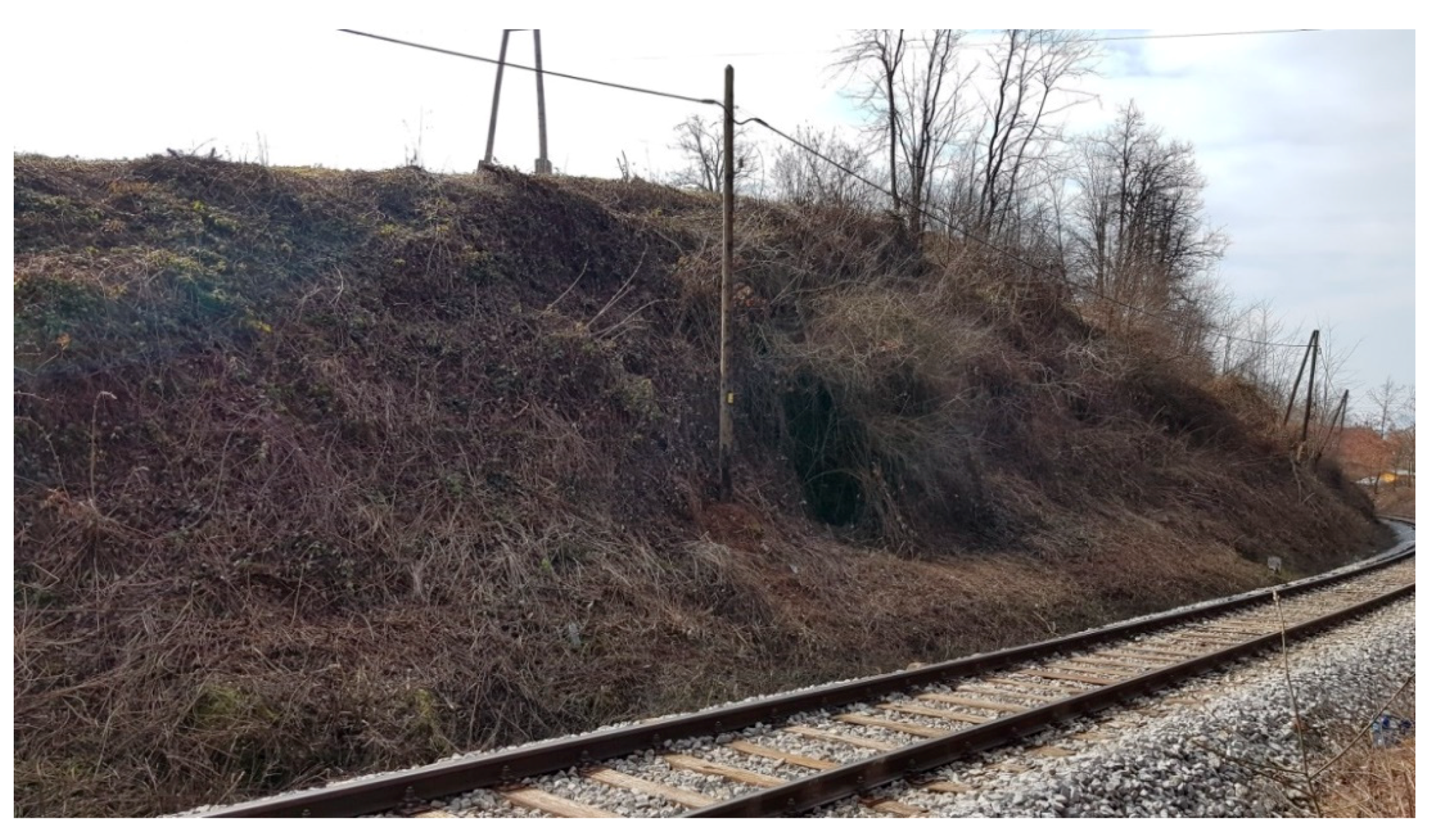
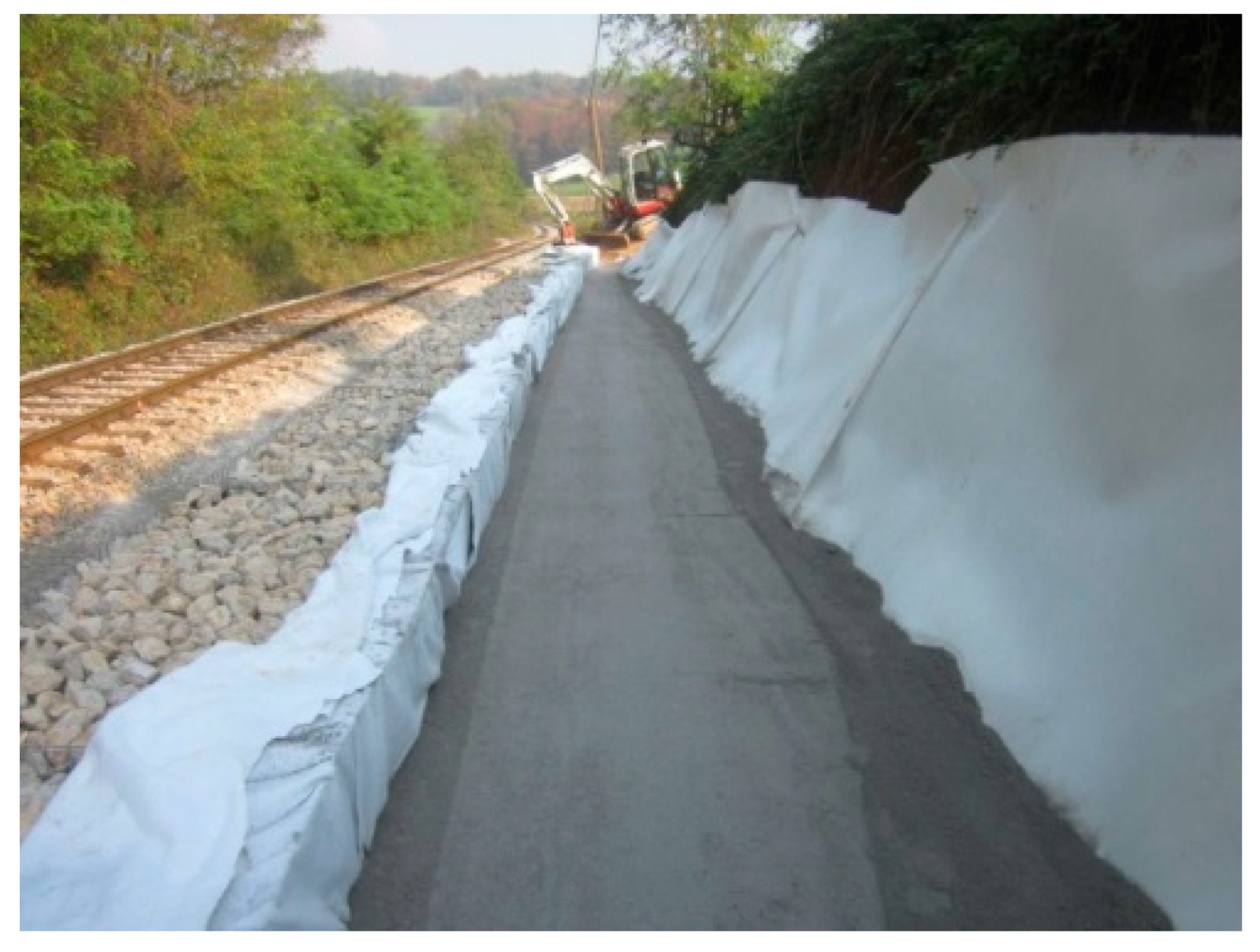
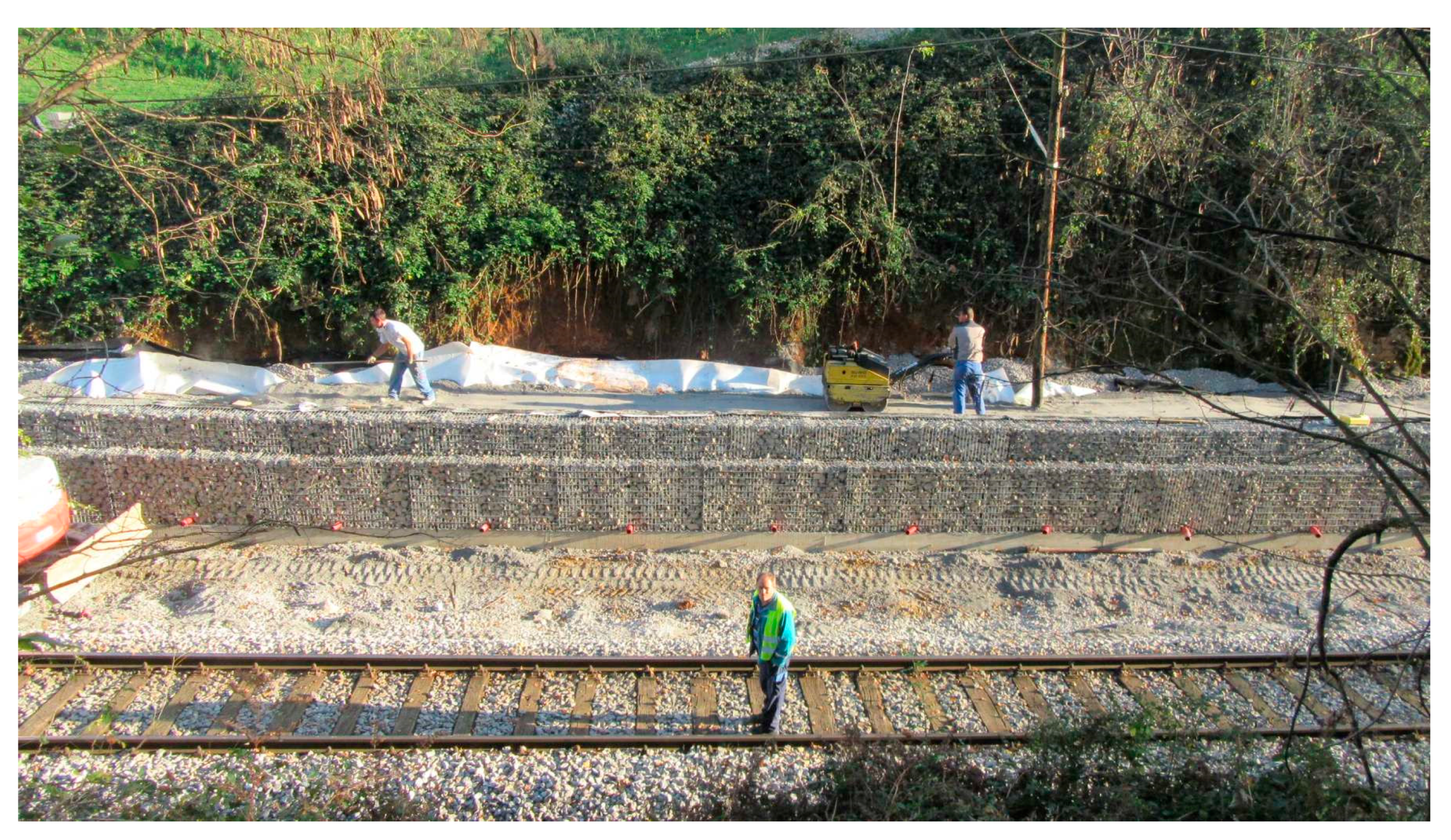
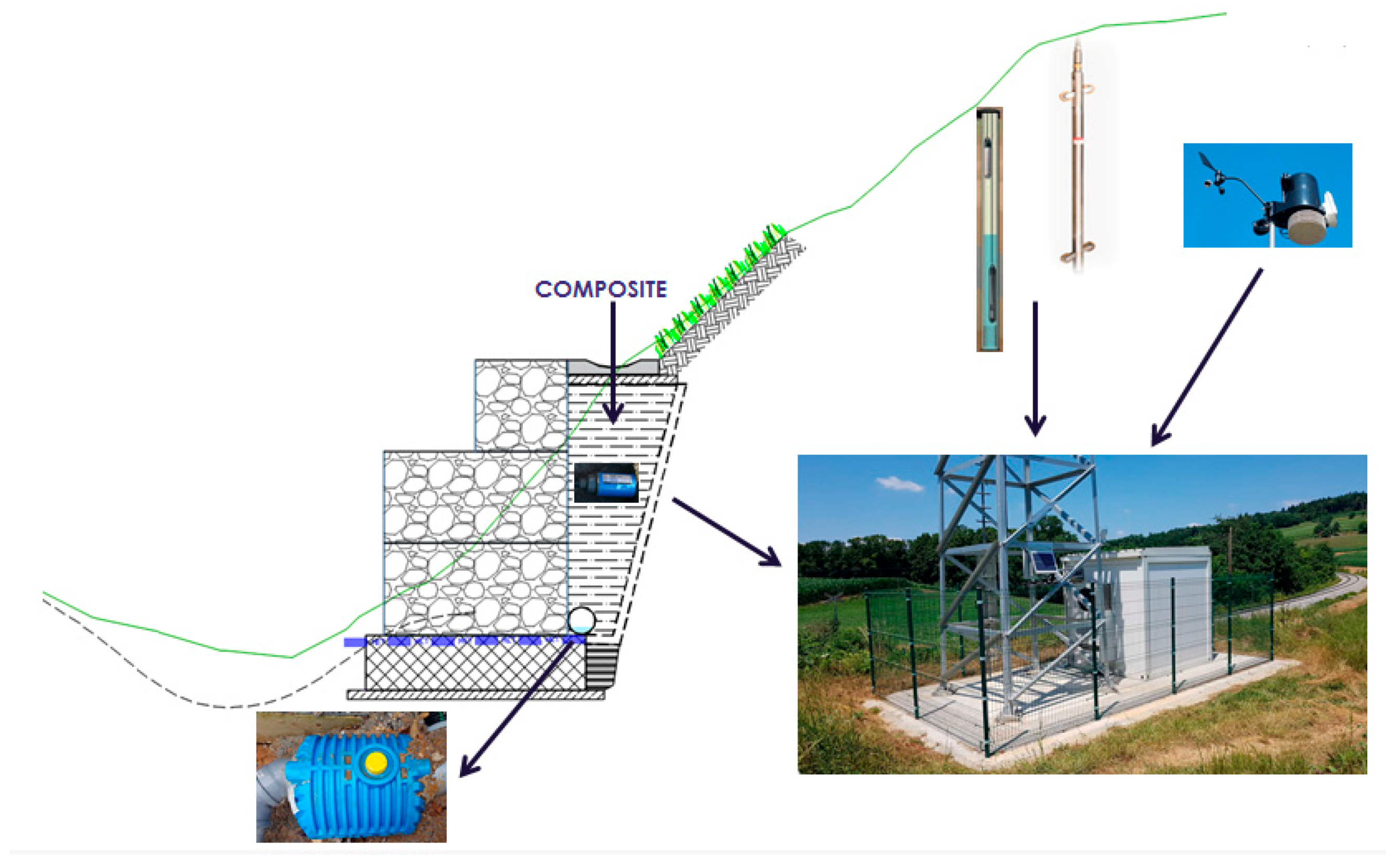
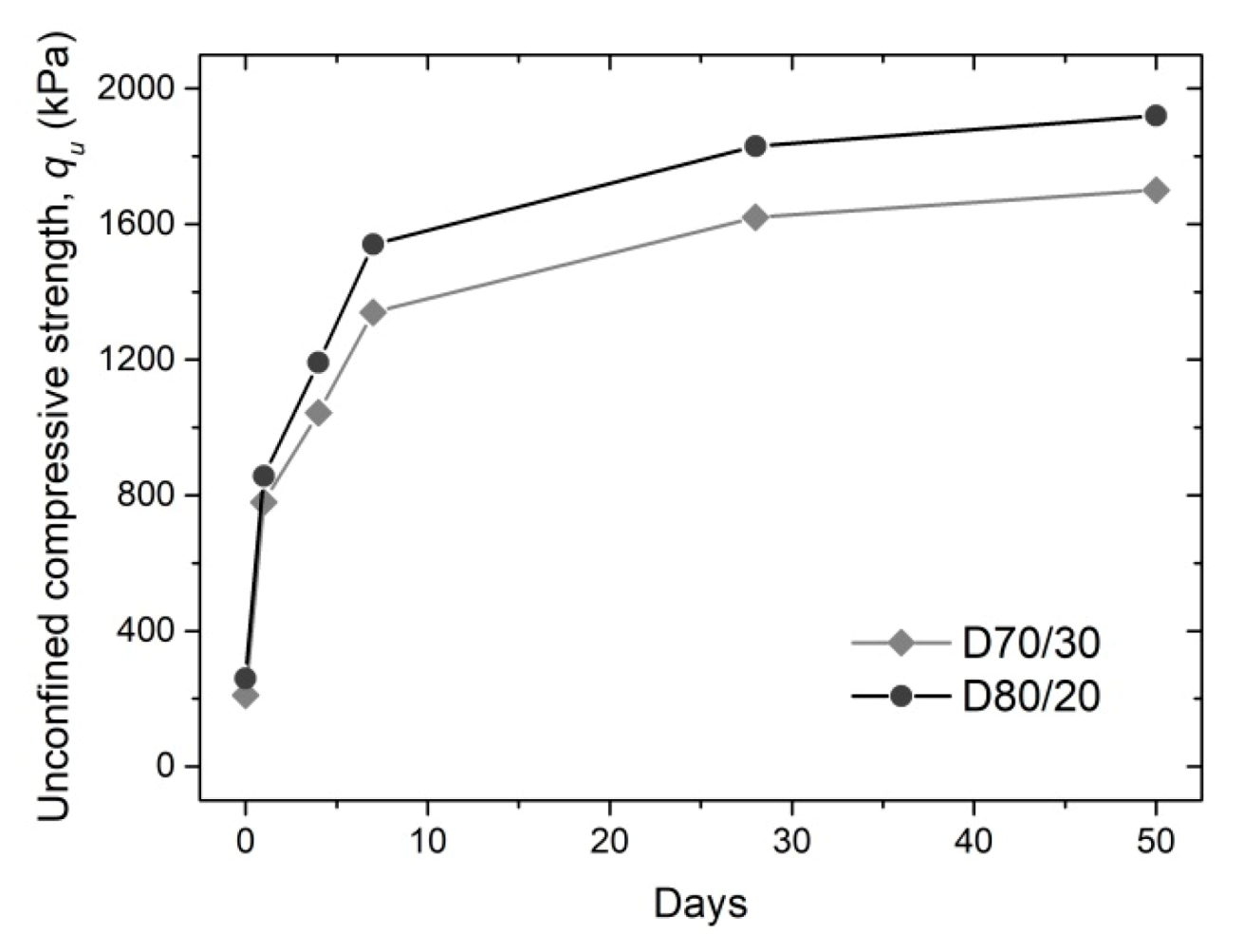
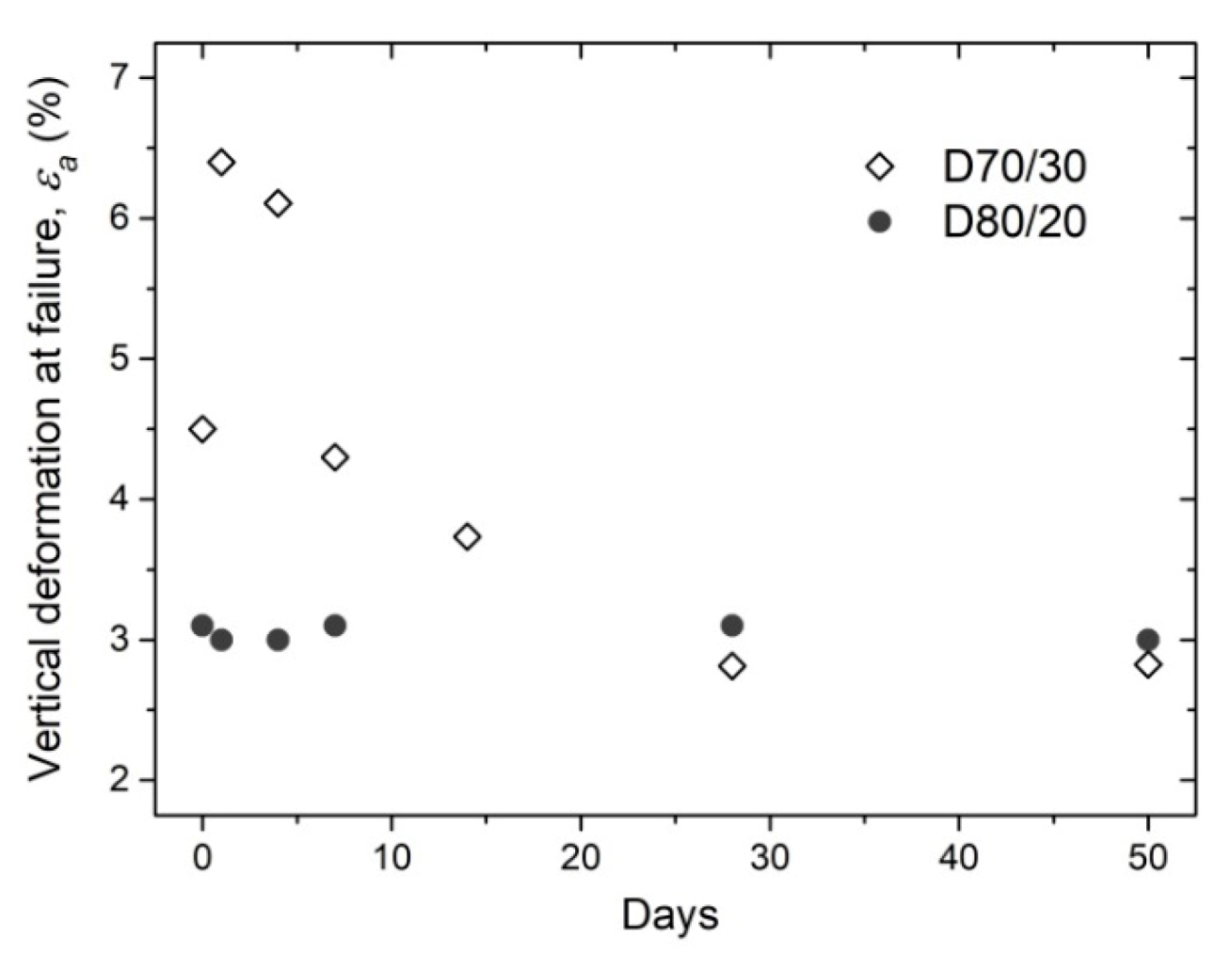
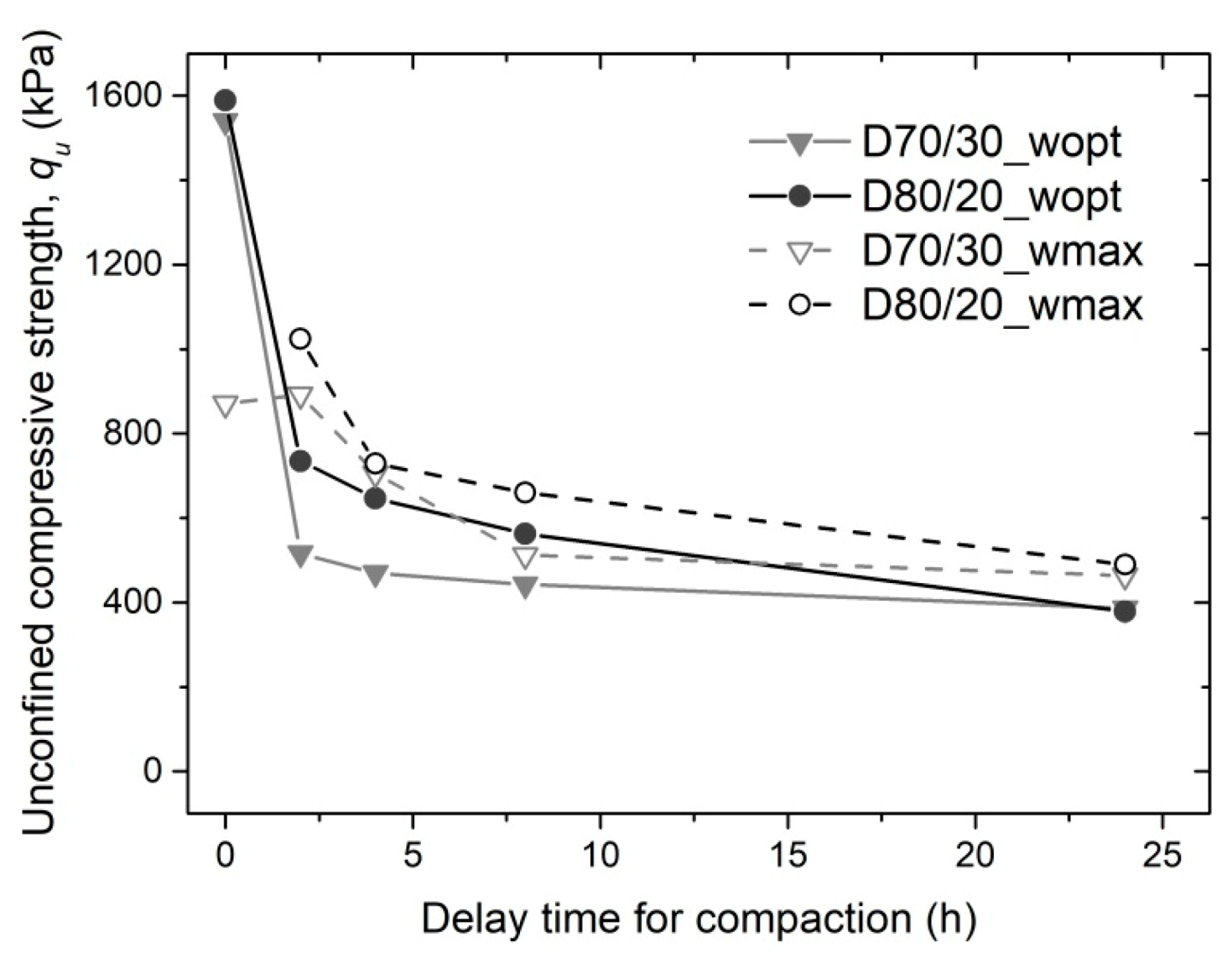
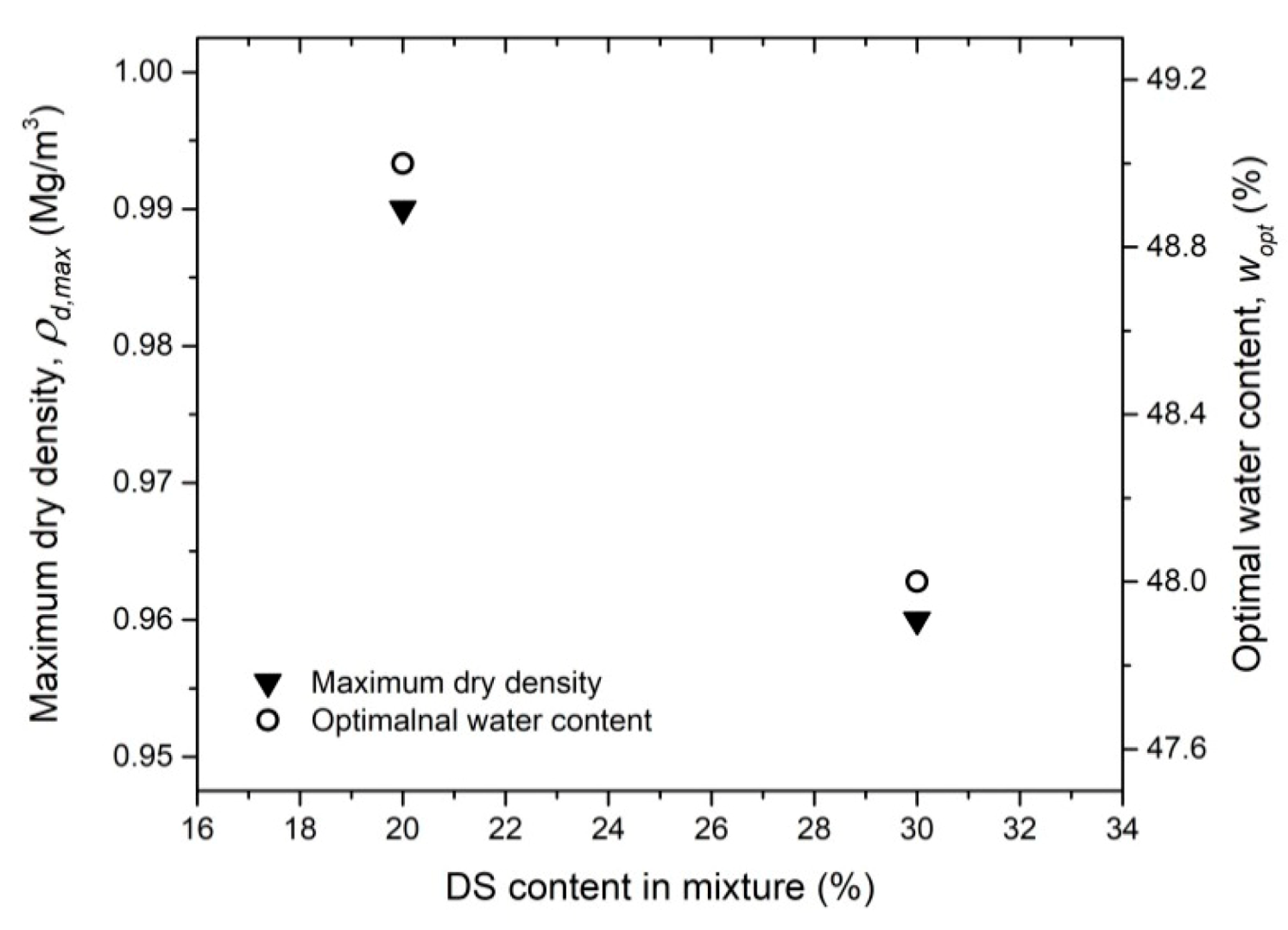
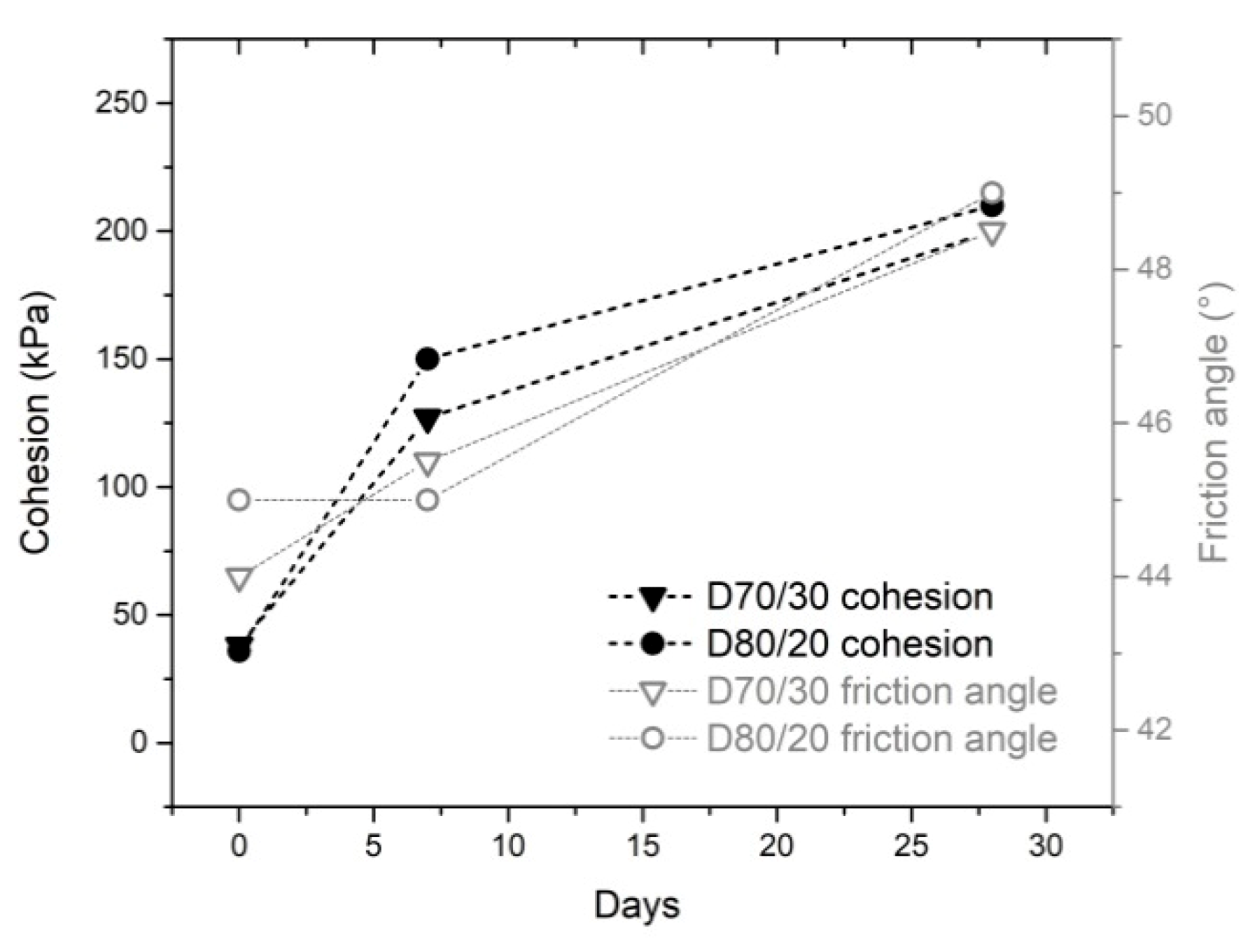
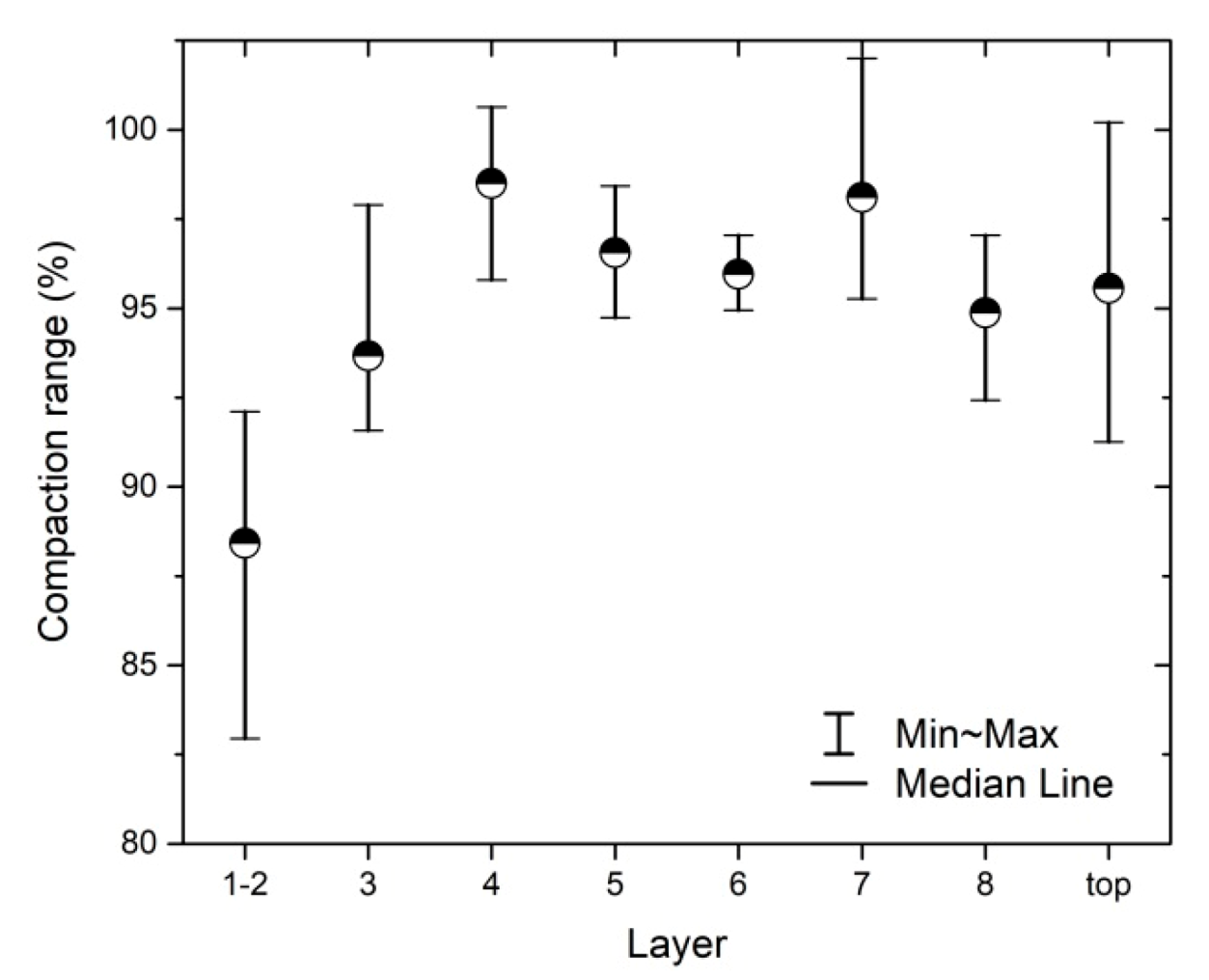




| Property | STANDARD |
|---|---|
| Initial Moisture Content (w) (%) | SIST EN ISO 17892-1:2015 |
| Specific Gravity (γs) (Mg/m3) | SIST EN ISO 17892-3:2016 |
| Optimum Water Content (wopt) (%) | SIST EN 13286-2:2010/AC:2013 |
| Maximum Dry Density (γd,max) (Mg/m3) | SIST EN 13286-2:2010/AC:2013 |
| Unconfined composite strength after compaction (qu) (MPa) | SIST EN 13286-41:2004 |
| Liquid Limit (LL) (%) | SIST-TS CEN ISO/TS 17892-12:2004 |
| Plastic Limit (PL) (%) | SIST-TS CEN ISO/TS 17892-12:2004 |
| Particle Size Distribution | |
| Particle (>2.5 mm) (%) | SIST EN 933-1:2012 |
| Particle (0.063–2.5 mm) (%) | SIST EN 933-1:2012 |
| Particle (0.002–0.063 mm) (%) | SIST EN ISO 17892-4:2017 |
| Particle (<0.002 mm) (%) | SIST EN ISO 17892-4:2017 |
| Designation of the Composites | Mixing Ratios (% Dry Mass) | |
|---|---|---|
| DSA | DS | |
| D80/20 | 80 | 20 |
| D70/30 | 70 | 30 |
| Raw Material | Parameter (wt%) | |||||||||||
|---|---|---|---|---|---|---|---|---|---|---|---|---|
| SiO2 | Al2O3 | Fe2O3 | CaO | P2O5 | MgO | K2O | Na2O | TiO2 | SO3 | LOI | Total | |
| DSA | 11.37 | 8.26 | 0.39 | 47.94 | 0.17 | 1.70 | 0.27 | 0.17 | 0.18 | 0.31 | 27.26 | 98.02 |
| DS | 7.27 | 5.56 | 0.24 | 31.78 | 0.06 | 1.03 | 0.16 | 0.14 | 0.11 | 0.06 | 53.41 | 99.82 |
| Property | DSA | DS |
|---|---|---|
| Initial Moisture Content (w) (%) | 0 | 45–50 |
| Specific Gravity (γs) (Mg/m3) | 2.64 | 2.15 |
| Optimum Water Content (wopt) (%) | 51 | 56.5 |
| Maximum Dry density (γd,max) (Mg/m3) | 0.99 | 0.89 |
| Unconfined compressive strength after compaction (qu) (MPa) | 0.3–0.5 | 0.22 |
| Liquid Limit (LL) (%) | ||
| Plastic Limit (PL) (%) | Nonplastic | Nonplastic |
| Particle Size Distribution | ||
| Particle (>2.5 mm) (%) | 0 | - |
| Particle (0.063–2.5 mm) (%) | 13.3 | - |
| Particle (0.002–0.063 mm) (%) | 75.59 | - |
| Particle (<0.002 mm) (%) | 11.11 | - |
| D10 (mm) | 0.002 | - |
| D50 (mm) | 0.02–0.06 | - |
| D90 (mm) | 0.4–0.8 | - |
| Shear Properties | Laboratory Results | Demo Field | Design Parameter | |||
|---|---|---|---|---|---|---|
| Immediately | After Seven Days | Immediately | After Seven Days | After 28 Days | ||
| F (°) | 44 | 45 | 37 | 40 | 45 | 40 |
| c (kPa) | 12 | 42 | 35 | 45 | 200 | 40 |
| Component | Limit | Sample One after Two Days | Sample Two after 28 Days |
|---|---|---|---|
| (mg/L) | |||
| As | 0.5 | 0.003 | 0.0033 |
| Ba | 20 | 16.04 | 8.82 |
| Cd | 0.04 | <0.002 | <0.002 |
| Cr total | 0.5 | 0.033 | <0.002 |
| Cu | 2 | 1.866 | 0.61 |
| Hg | 0.01 | 0.005 | <0.001 |
| Mo | 0.5 | 0.092 | 0.097 |
| Ni | 0.4 | 0.021 | 0.0064 |
| Pb | 0.5 | 0.005 | <0.005 |
| Sb | 0.06 | <0.001 | <0.001 |
| Se | 0.1 | 0.003 | <0.003 |
| Zn | 4 | 0.035 | <0.005 |
| Chlorides | 800 | 29.1 | 13.5 |
| Fluorides | 10 | 4.01 | 3.6 |
| Sulfates | 1000 | <10 | <10 |
| Component | Limit | Water Sample April 2019 | Water Sample May 2019 | Water Sample October 2019 |
|---|---|---|---|---|
| (mg/L) | ||||
| As | 0.1 | 0.0019 | 0.0006 | 0.0017 |
| Ba | 5 | 0.0080 | 0.0073 | 0.122 |
| Cd | 0.025 | <0.0002 | <0.0002 | <0.0002 |
| Cr total | 0.5 | 0.0031 | 0.0010 | 0.011 |
| Cu | 0.5 | 0.042 | 0.011 | 0.013 |
| Hg | 0.005 | <0.0001 | <0.0001 | <0.0001 |
| Mo | 1 | 0.018 | 0.0024 | 0.0028 |
| Ni | 0.5 | 0.0011 | 0.0015 | 0.0024 |
| Pb | 0.5 | 0.0005 | 0.0006 | <0.0005 |
| Sb | 0.3 | 0.0039 | 0.0011 | 0.0017 |
| Se | 0.6 | 0.0005 | <0.0003 | 0.0003 |
| Zn | 2 | <0.0005 | 0.0016 | 0.0005 |
| Chlorides | 800 | 5.17 | 1.52 | 2.19 |
| Fluorides | 10 | 0.264 | <0.10 | 0.204 |
| Sulfates | 1000 | 19 | 2 | 14 |
Publisher’s Note: MDPI stays neutral with regard to jurisdictional claims in published maps and institutional affiliations. |
© 2021 by the authors. Licensee MDPI, Basel, Switzerland. This article is an open access article distributed under the terms and conditions of the Creative Commons Attribution (CC BY) license (http://creativecommons.org/licenses/by/4.0/).
Share and Cite
Bizjak, K.F.; Likar, B.; Lenart, S. Using Recycled Material from the Paper Industry as a Backfill Material for Retaining Walls near Railway Lines. Sustainability 2021, 13, 979. https://doi.org/10.3390/su13020979
Bizjak KF, Likar B, Lenart S. Using Recycled Material from the Paper Industry as a Backfill Material for Retaining Walls near Railway Lines. Sustainability. 2021; 13(2):979. https://doi.org/10.3390/su13020979
Chicago/Turabian StyleBizjak, Karmen Fifer, Barbara Likar, and Stanislav Lenart. 2021. "Using Recycled Material from the Paper Industry as a Backfill Material for Retaining Walls near Railway Lines" Sustainability 13, no. 2: 979. https://doi.org/10.3390/su13020979
APA StyleBizjak, K. F., Likar, B., & Lenart, S. (2021). Using Recycled Material from the Paper Industry as a Backfill Material for Retaining Walls near Railway Lines. Sustainability, 13(2), 979. https://doi.org/10.3390/su13020979






